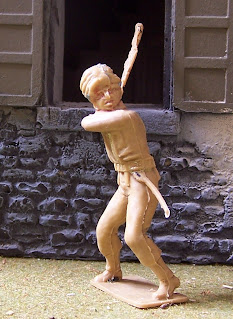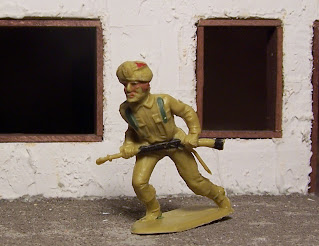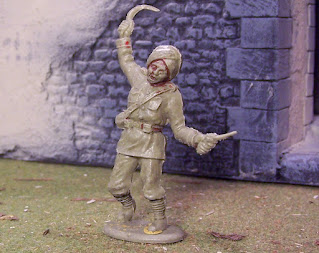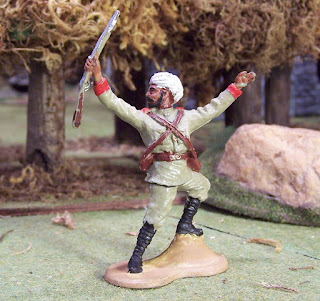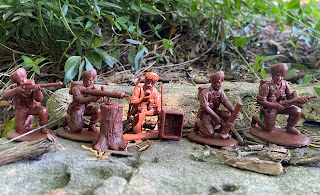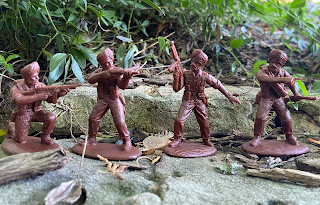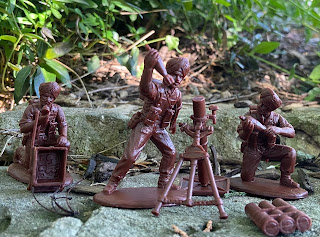Latest Edit: Added Expeditionary Force Sets
___________________________________________
India, a British colony during WWII contributed a substantial amount of manpower to the Allied cause. Between 2 and 2.5 million men volunteered to serve. They fought in places like North Africa, Burma, and up the Italian boot. I actually started looking into Indian troops after I read a book on Monte Cassino, where they also fought. A less known part of history is that Indian troops also fought on the Axis side. Both Japan and Germany formed several divisions mainly from prisoners of war whose motivation was to seek independence from the British. The guys in these pictures represent the men who fought on the Allied side. Indian troops are sometimes also referred as Sikh Infantry because of many of the men's religion. However, not all of them were Sikhs, many were Muslim. Apparently, the way to tell them apart is by the head dress. The Muslim head dress has two parts. The Khulla is a conical cover for the head, which is then wrapped many times with a Pagri. The Sikh troops on the other hand wear a turban that does not have the conical Khulla in the middle.

Atlantic Indian Brigade - Part 1
These are really the only WWII Indian troops that I have come across. They are nicely done, however their uniform seems better suited for the jungles of Burma or the North African desert, than for the cold and damp mountainous terrain of Italy at the time of the Monte Cassino campaign which is what I originally wanted them for. But I guess they will have to do. Note that these figures have been manufactured in several different shades of brown. But don't worry, each set only includes figures in one color. The machine gun in this set is a nice touch that provides the unit with a good dose of fire power.
Atlantic Indian Brigade - Part 2
The most interesting part about these figures is that three of them offer the possibility of inserting swords and large knives into their hands. Depending on what weapon you use and whether it points forward or backwards, the figure can be stabbing with a knife or striking a blow with his sword. You can also give them other types of accessories (if you have spare weapons from other manufacturers), for instance, the guy in the middle can also be carrying a bazooka across his back and holding the handle in his hand.
Charbens Punjabs - Part I
These guys are supposed to be from around the turn of last century (1900), but given the scarcity of manufacturers tackling these figures I have decided to recruit them into this unit. The main thing is that they are wearing a similar head dress -albeit Sikh- and the rifles and swords don't look that different from what the Atlantic guys are carrying.
Charbens Punjabs - Part II
Here is the original, vintage officer. Still in decent shape, with most of the original colors on him. And he is a bit larger than the clones pictured above, which is no surprise, as there's often shrinkage when the figures are cloned.
Cherilea 60mm Sikh Infantry
Here are a few other guys that I recently found. Being 60mm, they are indeed on the larger side, but I think they will still blend in once they are painted. The poses are well sculpted and dynamic, plus they provide the only prone guy that I have come across. Too bad I could not get a hold of the whole set (usually 6 from Cherilea).
Cherilea 60mm Sikh Infantry - Part II
Here is another guy from the same set. I got it after the initial post. Unfortunately the tip of the gun is missing, but overall it is a nice pose. Will need to give it a good scrub before painting it.
Cherilea 60mm Sikh Infantry - Part III
Here is another guy from the set. I've had to get the missing figures individually.
Cherilea 54mm Sikh Infantry?
This guy came with the other 3 above, but I suspect he is from a different set as he is a bit smaller, plus the shape of the base is slightly different, not to mention the slightly different material. I have to say however that I don't know for sure if Cherilea also released a set in 54 mm, so maybe they are from an entirely different manufacturer. If you know, let me know!
Crescent Sikh Infantry - Part I
These are some guys that I have been trying to get for a while. They are 54mm figures. I believe the set contained 6 of them, but I have only been able to find 3. They are also pre-WWII figures, but as you can see, they should blend in.
Crescent Sikh Infantry - Part II
One more from the set. I actually had to get a batch of 20+ mixed figures just to get this one extra pose. I find the figure a bit puzzling. On the one hand he appears to be leading a charge, but in that case, you would expect his expression to be more lively. Perhaps he jut got hit? But then he would be losing his balance, wouldn't he?
Crescent Sikh Infantry - Part III
And one more, with a good deal of original paint left on him.
Crescent Sikh Infantry - Part IV
This is the last one. An action pose, rallying his comrades to move forward. This guy's paint has been touched up by the previous owner, which actually makes his beard look pretty good.
Armies in Plastic WWI Indian Army - Part I
I had been looking for Indian troops for a Monte Cassino scenario and was pleased to run into these guys which were recently released. The poses are nicer than some of the previous AIP figures. Less bulky and with some good movement in them. The level of detail is good and the turbans and beards make them unequivocally Indian. The uniforms and weaponry are close enough to make them pass for WWII figures.
Armies in Plastic WWI Indian Army - Part II
The first picture shows some of the more active poses. This other five guys are in a more static or defensive stance. Both are needed to depict a good battle scene. All in all, a nice and useful set from AIP. Will paint up well next to the Atlantic, Cherilea, Charbens and Crescent guys.
Expeditionary Force Indian Assault Section - Pacific War
This is a very welcome set, as there haven't been any recent WW2 Indian Army sets. Considering that they are assembled using the same bodies as the Expeditionary Force British Infantry figures, I had some concerns about the ability to make them look like their own set just by giving them a different head, but once they are assembled, they look just fine. I only have two bits of criticism. The first one is that you only get two different types of heads, and they are very similar to each other. The only difference is that one of them has the mouth slightly open. The end result is that all your men look like clones of each other. The second observation is that the body build of these guys is a bit robust and Indian men tend to be slimmer. But I am totally happy with this trade off. Much better to have these strong Indian guys than none at all. Lastly, you do have to get a bit creative to pose them in ways that are slightly different from the other Expeditionary Force Commonwealth sets, although that's probably not a big deal anyhow unless you plan to deploy them on a scene side by side.
Expeditionary Force Indian Defense Section - Pacific War
And here we have the Indian Defense section. In this case the man behind the stump is firing a Bren gun, which sets him nicely apart from the other two Defense Section sets. Other than this difference and the head gear, the rest of the men are equipped very similarly as the British and Australian sets. A couple of sub machine guns, although one of them is a Sten gun, and the rest are regular riflemen, and one officer. And there's also the grenade thrower. You can play with the positioning of the heads, and arms to provide a bit of variation.

Expeditionary Force Indian Machine Gun Section - Pacific War
The third MG set is for the Indian Army. Again, a nice degree of differentiation is achieved simply through the headgear. One thing that you do have to pay attention to when gluing the MG teams together is that the cooling box may easily end up being pulled upwards when you glue it to the side of the Vickers gun. You need to hold it down so that the base does not end up lifted up in the air. And you also want to make sure that when you set the arms of the loader, the back leg of the MG's tripod is resting on the base of the gunner. Else, the ammo belt will not line up properly with the slot where it is supposed to fit in. Lastly, the bodies of the ammo loader and the gunner looks similar, but they are actually different so make sure you glue the correct set of arms to each, or else the bases will get in the way of each other and the ammo belt will not reach the MG. Yes, I had to redo my first set because I did not pay attention to these small details the first time.
Expeditionary Force Indian HQ Section - Pacific War - Part I
In the case of the Indian HQ section, I also gave them a kneeling sniper and a kneeling man with the sub mg at the ready at the waist. The other 3 poses are the standard ones, but if you pay attention you may notice that for some reason the sun decided to highlight the radio man. It only happened in this picture. Maybe he has some critical message to relay in his upcoming battles?
Expeditionary Force Indian HQ Section - Pacific War - Part II
The rest of the HQ section is ready to move forward and complete its mission. The officer and the NCO are issue instructions and the other two guys are ready to neutralize anything that moves. What's nice about these Expeditionary Force figures is that the headgear really makes them look different from the other sets.
Expeditionary Force Indian Mortar Section - Pacific War - Part I
These guys are setup the way they were originally meant to be assembled, with the standing guy dropping the shell, and the kneeling one handing over the next one. In this case, the targets are being relayed to them by radio.
Expeditionary Force Indian Mortar Section - Pacific War - Part II
This one is a slight variation on the previous one, with the standing guy reaching out with his left hand to perform some adjustment on the mortar before dropping the shell. And they also got the NCO to direct their fire.
Expeditionary Force Indian Mortar Section - Pacific War - Part III
I had to get a bit more creative with this last crew. I made the man on the left stand ready drop the shell with two hands, and in this case the kneeling man is performing some adjustments, while holding another shell on his right hand. The officer is in charge here.





























